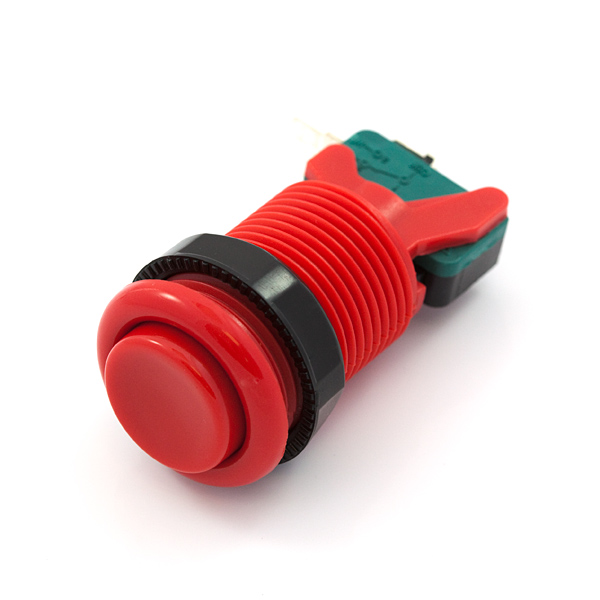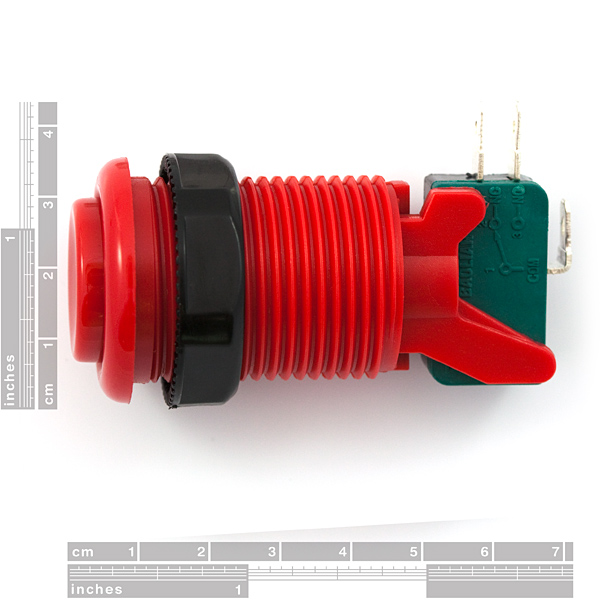This is a 35mm concave momentary push button similar to the ones you find on arcade games. Simple screw in design. Perfect for mashing. This button has a great tactile, 'clicky' feel.
- Concave plunger design
- Durable nylon material
- Microswitch: max 3A @ 120 VAC
- Microswitch reliability tested to 10,000,000 cycles
- Includes 3 terminal microswitch
- Net weight: 25g* Bezel diameter: 32mm
- Overall height: 65mm
- Mounting hole: 1 1/8th inch paddle bit (1.125" / 28mm)
Concave Button - Red Product Help and Resources
Build a Qwiic Jukebox that is Toddler Approved!
March 29, 2019
Follow this tutorial to build your own custom jukebox. Note, this is designed simple and tough for use primarily with toddlers. It's also a great introduction to SparkFun's Qwiic products!
micro:arcade Kit Experiment Guide
July 21, 2017
We love games! We love writing games, building games and yes, even building game consoles. So we want to introduce to you the micro:arcade kit for the micro:bit!
PiRetrocade Assembly Guide
October 28, 2016
Build your very own retro gaming controller with a Raspberry Pi using the SparkFun PiRetrocade Kit!
Button and Switch Basics
May 7, 2013
A tutorial on electronics' most overlooked and underappreciated component: the switch! Here we explain the difference between momentary and maintained switches and what all those acronyms (NO, NC, SPDT, SPST, ...) stand for.
Dimensions
Rough dimensional drawing can be found here => [ https://drive.google.com/a/sparkfun.com/file/d/0B0jwgLkjMWzDOHV4ZDBqQVFXZm8/view?usp=sharing ].
Core Skill: DIY
Whether it's for assembling a kit, hacking an enclosure, or creating your own parts; the DIY skill is all about knowing how to use tools and the techniques associated with them.
Skill Level: Noob - Basic assembly is required. You may need to provide your own basic tools like a screwdriver, hammer or scissors. Power tools or custom parts are not required. Instructions will be included and easy to follow. Sewing may be required, but only with included patterns.
See all skill levels
Core Skill: Electrical Prototyping
If it requires power, you need to know how much, what all the pins do, and how to hook it up. You may need to reference datasheets, schematics, and know the ins and outs of electronics.
Skill Level: Noob - You don't need to reference a datasheet, but you will need to know basic power requirements.
See all skill levels
Comments
Looking for answers to technical questions?
We welcome your comments and suggestions below. However, if you are looking for solutions to technical questions please see our Technical Assistance page.
Customer Reviews
5 out of 5
Based on 2 ratings:
1 of 2 found this helpful:
Great buttons
These buttons have a nice mechanical feedback, feel solid and look good. Will buy again.
Satisfyingly clicky
Used a couple of these to build a replacement joystick platform for an Atari 2600. Nice and clicky, and the switch itself is easy to replace if that ever becomes necessary.



It's worth noting that in order to mount the button, the switch will first have to be removed from the assembly. This is best accomplished by using a small screwdriver to pry back a plastic tab that has a knob that fits in a hole of the actual switch. The switch can then be rotated and the other knob comes out much more easily.
I like the fact that this is a SPDT switch: that way you don't need pull-up or pull-down resistors, just connect the common to the input and the other two to 0V and VCC
Especially if you're connecting to anything CMOS, you really still should use them. Otherwise, the input gates are left flapping in the electric wind during the travel time of the switch. Might not be a big issue with BJT devices, though.
Feels a bit cheap, but looks nice. Does the job.
Can someone give me an idea of how much bounce to expect from this switch? I've only ever used breadboard push button switches before. Would something like this be appropriate?
I bought this to use with el wire, but when I put this between my inverter and the el wire the inverter no longer works as if it thinks there is a short somewhere. Any idea why this would be happening?
You should be turning off the inverter, not the wire
Although the Button is rated for AC current there's probably more than 3 Amp going through it. The button is probably dead but that still doesn't explain the dead inverter.
Love the action! Want other colors. Don't make me order elsewhere!
While these guys are a bit more expensive then the 33mm convex ones sold here, they're actually a pretty good deal when you consider the fact that the microswitch included with them is over 3/4 the price. You only paying $0.45 more for the nifty arcade button.